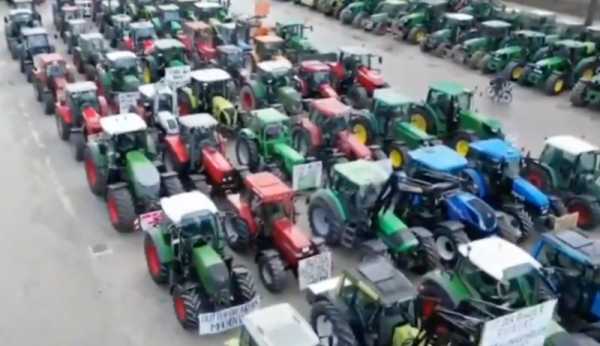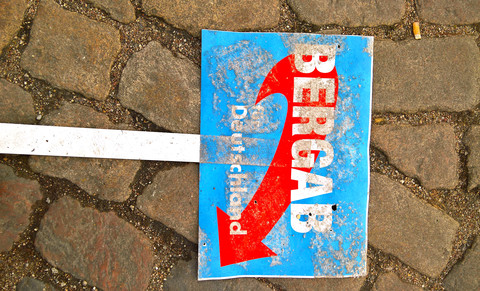
Many farmers are deeply conservative. They resent both the concentration process of recent decades, which has put an end to many small family farms, and the current government's plans for more green, sustainable agriculture (Photo: Screengrab/Twitter)
This Monday (8 January), German farmers tried to bring the country to a standstill. Tens of thousands took their tractors to motorways and city centres in a bid to effectively blocking them to other road traffic, in just the first day in a whole week of protests.
Ostensibly, the farmers are demonstrating against a series of cuts to agricultural subsidies for farm vehicles and fuel that would amount to about €450m.
-

The ethnonationalist ("völkisch") movement, now partly merged with the anti-vax "lateral thinkers", is back on the streets, even if it uses the farmers to artificially inflate its apparent support, and the AfD has become its parliamentary arm (Photo: Lemke, Martin)
These cuts were hastily announced in December, after a ruling by Germany’s highest court forced the government to cut spending in 2024 by a total of €17bn. The ‘traffic light’ coalition, comprised of the ‘red’ Social Democrats, ‘yellow’ Liberals, and the Greens, quickly backtracked after a first wave of protests hit the country before Christmas, suggesting that one set of subsidies could remain in place while the other would be phased out over three years. But farmers are unwilling to accept any changes to the subsidies.
What is more, many of the protestors are not prepared to stop there.
Their largest pressure group, the German Farmers’ Association, which forms the organisational backbone of the protests, is closely linked to the Christian Democratic CDU/CSU parties. Many farmers are deeply conservative. They resent both the concentration process of recent decades, which has put an end to many small family farms, and the current government’s plans for more green, sustainable agriculture.
Their stated aim is not just to retain the vehicle and fuel subsidies (which are a relatively small part of the total subsidies received by farmers), but to bring down the government with its new-fangled ideas.
Against this backdrop, many political observers feared that the far-right would hijack the protests. In some cases, this did happen.
In Munich, members of the Identitarian Movement (IB) and other rightwing extremist splinter groups took part in the demonstrations without being challenged. In the eastern city of Cottbus, a large number of supporters of the far right AfD joined a convoy of tractors with their own cars, effectively taking over the protest and shutting down the city centre. In Dresden, which has been a hotspot for far-right mobilisation for decades, rightwing extremist groups reportedly outnumbered the farmers, too.
At other places, some farmers themselves showed up with far-right stickers or symbols, such as the plough-and-sword flag of the Landvolkbewegung (Rural People’s Movement). The Landvolkbewegung is an extremist group that dates back to the 1920s, when it helped to pave the way for the Nazis in rural areas.
The most shocking event, however, took place the week before — on 4 January. As the economy minister and vice-chancellor, Robert Habeck (of the Greens), and his family returned from a day trip to a small island off the Frisian coast, a group of farmers shot fireworks at the ferry and blocked the dock, making it impossible for Habeck and other passengers to disembark. The local police were unable to control the mob. When the farmers refused Habeck’s offer to talk to them and instead tried to storm the ship, the captain was eventually forced to leave the port, with Habeck still on board.
According to an investigation by Die Zeit newspaper, an AfD politician was on board of the ferry, too, and spotted Habeck during the outbound journey. She contacted her partner, a well-known far-right activist and contractor, who then organised the blockade. The public prosecutor has now opened an investigation into the events, the details of which are still unclear.
This act of coercion against Germany’s deputy chancellor and his family sent shock waves through the republic and put considerable pressure on the Farmers’ Association to distance itself from the far right. As a result, the far-right has been largely absent from most protests and has played little or no role in instigating them.
Surfing the wave
Nevertheless, far-right groups have made good use of footage of the demonstrations on social media. For weeks, such actors had been trying to surf the wave of protests in a mostly opportunistic way, spreading fantasies of a revolution against the ‘system’. Now they are using the images of blocked roads and angry crowds as proof of their claim that this is the beginning of a popular uprising against the ‘regime’ of the elites.
In reality, the far-right is still operating on the fringes of the current protests.
But all is not well with democracy in Germany. The ethnonationalist (“völkisch”) movement, now partly merged with the anti-vax “lateral thinkers”, is back on the streets, even if it uses the farmers to artificially inflate its apparent support.
The AfD has become its parliamentary arm and is polling double its 2021 result nationally. Moreover, even if the far-right has little direct influence on them, some of its tactics have already spilled over into the farmers’ protests: the use of effigies on gallows and the harassment of politicians in their private lives.
This points not just to a loss of civility, but to a decline in liberal democratic norms. All democrats must stand together against this threat.
Source: euobserver.com



